Onions are not only a healthy food product. They can also be found in various cartoons and animated series that children like. The most popular cartoon is "Cipollino", where the main character, an onion, lives the life of a child. You can introduce children to the world of vegetables using drawings and children's films.
Pencils, paper and supplies
To draw a bow with a simple pencil, you will need a set of mandatory and optional tools:
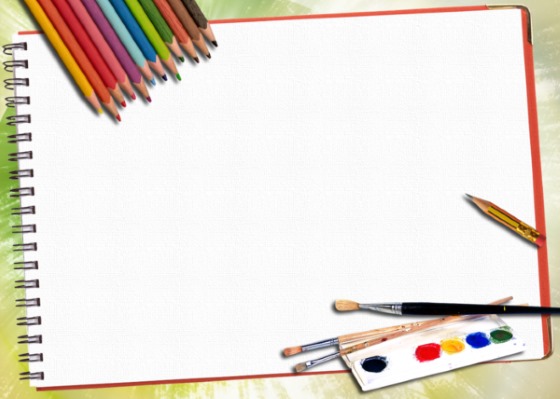
| Necessarily | Not necessarily |
|
|
Depending on the desired effect, it is necessary to select an individual set of devices.
Simple pencil drawing
The onion (a drawing for children with a simple pencil) is quite easy to draw, and as an additional decoration you can use colored pencils. They allow you to create a natural effect, but at the same time do not make it too difficult for the child in the process of work.
Step by step process of execution
The step-by-step process of doing the job is quite simple:
- On a clean sheet of paper, draw a long diagonal. It is recommended to draw it from one corner of the sheet to the other.
- Draw an uneven roundness at the bottom of the sheet. The middle of the circle should pass along the plane of the previously drawn diagonal.
- In the lower right corner, on the drawn roundness, add short curved lines that will extend the surface of the circle towards the previously drawn diagonal.
- Connect the drawn curved lines with zigzag lines to form the bottom of the onion.
- Draw similar lines of a larger size in the upper part of the drawing. From them form green young shoots and long leaves in the form of arrows. The approximate location of the figures can be seen in the drawing.
- Using a hard pencil, draw the outline of the bulb itself, and also add detail to the upper leaves.
- Use an eraser to remove excess lines.
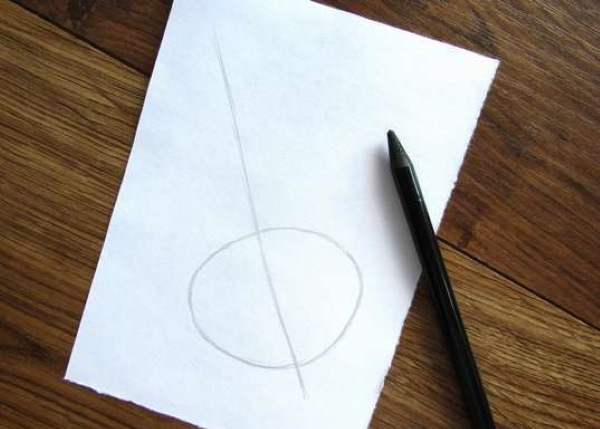
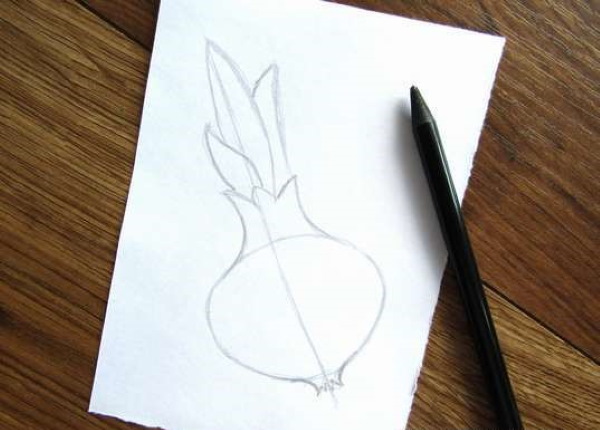

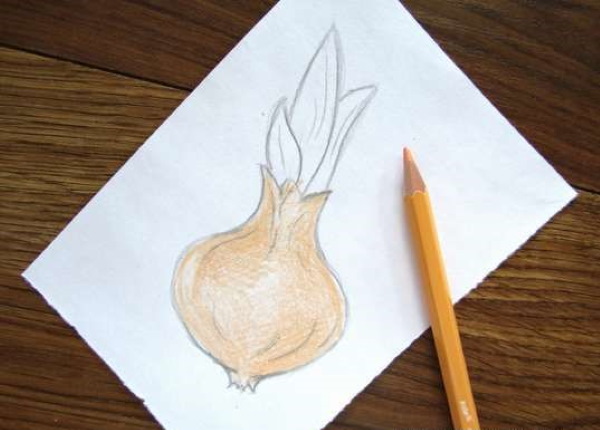
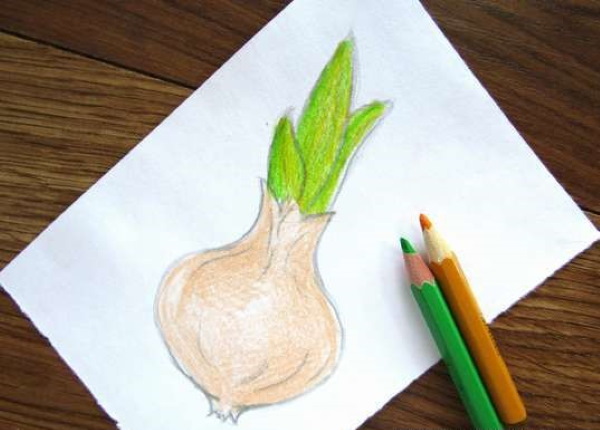
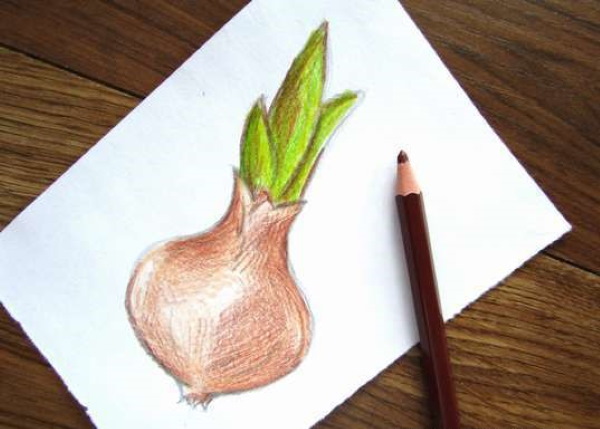
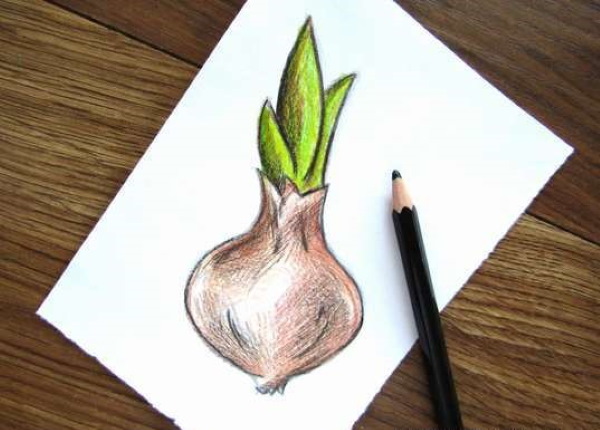
At this stage, you can leave the drawing as is, but for greater visualization, it is recommended to color the prepared sketch with colored pencils or paints.
Onion (a drawing for children in simple pencil with the addition of coloring), despite the association with an unpleasant smell, looks quite cute.
It can be colored with colored pencils using only 5 colors:
- Use a beige pencil to paint the area of the vegetable that is covered with peel. This shade is the base tone for the image of vegetables.
- The green shoots located at the top of the drawing require the use of bright, juicy colors. To do this, the upper area is filled with a bright green shade, and then yellow elements are added.
- To create the illusion of a natural product, a brown pencil is used. This shade is used to create areas of shadow and half-shadow.
- The color is applied to the sides of the bulb, as well as to the upper part of the stems, and the places where the leaves join are darkened.
- Using a black pencil, duplicate the outline, the darkest areas of the bulb, and the detail lines on the surface of the husk. This makes the drawing clearer.
The resulting bulb can become an element of a painting or be used as an individual design.
Onions in the garden
Onions (a drawing for children using simple and colored pencils) can be drawn in combination with beds in the garden. It is necessary to take into account that there are different stages of development of the onion, which can be told to the child as an educational conversation.
Step by step process of execution
Algorithm for performing work:
- On a clean sheet of paper, draw a line parallel to the bottom of the sheet by hand or with a ruler.
- From this line draw the bulb. First draw an oval with an extension in the middle.
- At the top, add angular shapes to form the top of the bulb.
- Draw onion feathers depending on the stage of development of the vegetable - focusing on the presented image. The number of onion feathers can be any.
- Add oblong lines on the surface of the onion to represent the texture of the skin.
- From the straight vertical line drawn earlier, form an uneven ground surface.
- Use the eraser to remove unnecessary elements from the image.
- Add the root system and the lower part of the bulb - optional. In this case, you need to draw small stones and the texture of the soil around to show the inner part of the earth.

This image can be used as an example. Additionally, you can draw the root system of the plant - depending on the size of the bulb, the length and number of roots change.
Onion in section
Onion (drawing for children with simple pencils) can be drawn in section. The prepared sketch looks advantageous if you color the prepared image with paints.
Step by step process of execution
Step-by-step process of completing the work:
- Draw 2 oval shapes by hand on a sheet of paper. First, arrange the material horizontally for greater convenience and drawing of large shapes. The circles should intersect each other in a small area.
- The right drawn oval will be a whole onion, and the left one will be half of the vegetable.
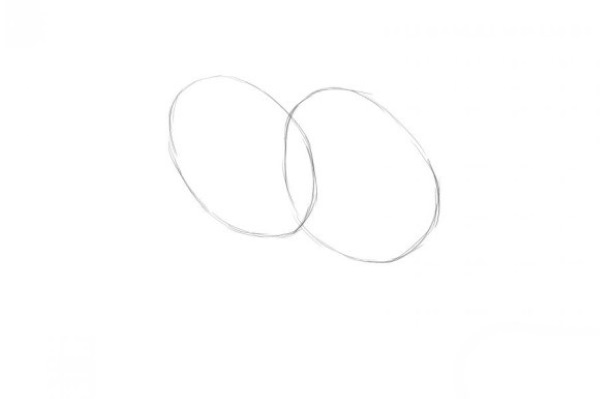
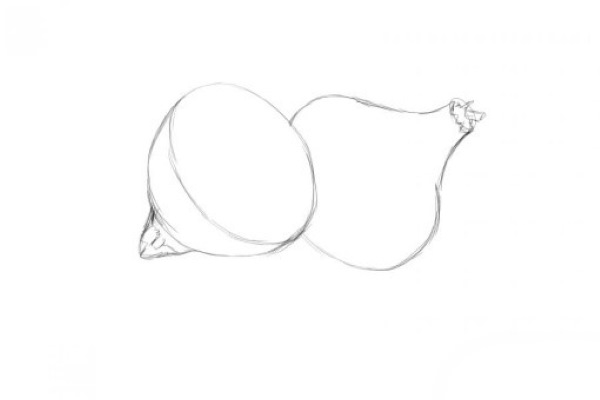
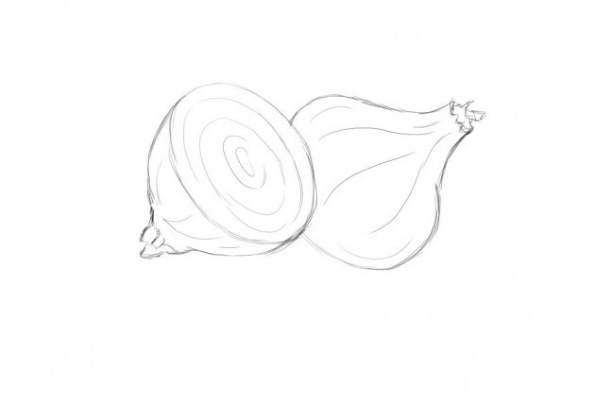
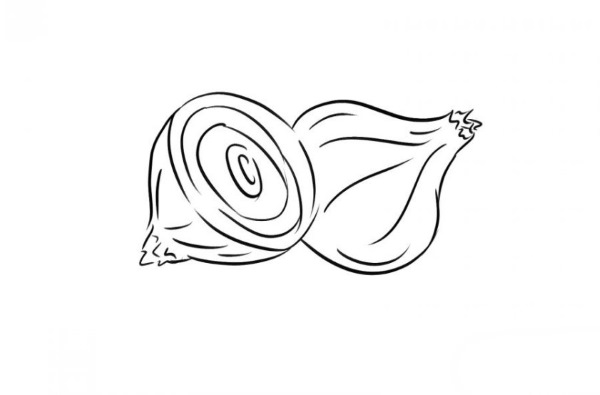
- Add a curved shape to the left figure, forming the lower part of the bulb. Also add a triangular top.
- From the right figure, form a whole onion by adding curved lines, connecting them with a small cylinder.
- Detail the tips of the bulbs and remove unnecessary elements of the image.
- On a whole onion, draw the texture of the peel - longitudinal, slightly curved lines across the entire surface of the vegetable.
- On half an onion add onion rings - the middle of the product. To depict the elements you can use a compass or form them manually.
Duplicate the details with a hard pencil. Remove unnecessary elements with an eraser. Gouache or watercolor can be used as additional decoration. It is quite easy to color the resulting sketch.
| Stage | Description of the stage | Image |
| 1 | Yellow paint is used as a base. If gouache is used in the painting process, it is necessary to dilute the paint well in water until a light effect is obtained. Apply paint to a thick brush and paint the peel area to achieve a light effect. In areas of natural shadow, add additional paint after the initial layer has dried. |  |
| 2 | On the palette, mix a few drops of white and a little brown, add a little yellow. Mix the color and adjust the shade until you get a light beige.
Fill the cut of the bulb with the resulting shade. You can darken the shade a little at the bottom of the half. | 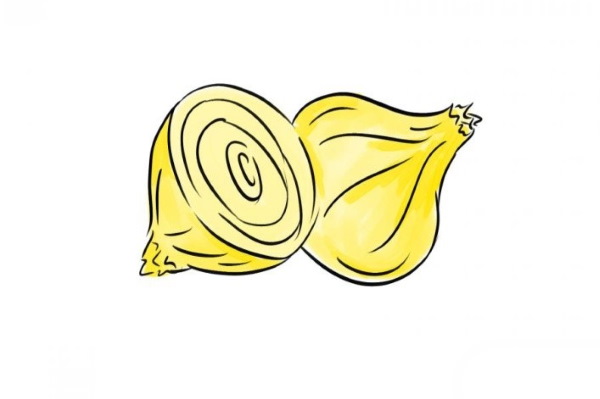 |
| 3 | Use brown and black shades to mark the places of obvious shadow. When performing this step, it is necessary to focus on the presented image. | 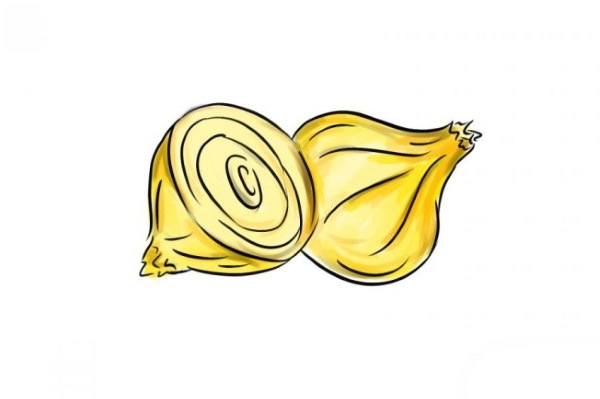 |
| 4 | Use white paint or a pencil (in this case, you need to work only on the dried drawing) to draw highlights on the surface of the cut and the peel. If the image will later be used as an element of the painting, then the highlights are arranged depending on the location of the light. | 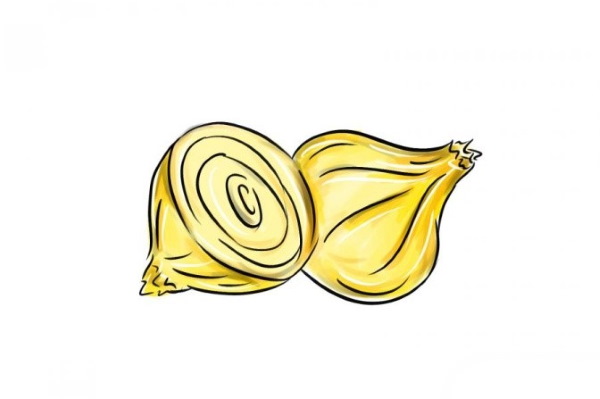 |
The finished drawing must dry in a vertical position. It is not recommended to dry drawings using a hair dryer or iron, or in direct sunlight.
Onions for little kids
The bow can also be drawn in a simpler version. This image is suitable for younger children, as it does not require special attention to detail and you can use improvised tools.
Step by step process of execution
Algorithm for performing work:
- Using a compass or a round object, draw a perfect circle on a clean sheet of paper. From the top, draw a figure resembling a trapezoid, the upper lines of which are lengthened.
- At the bottom of the drawn circle, opposite the previously drawn trapezoid, add the root system of the bulb. To do this, you can draw short, winding lines tangled with each other.
- Use an eraser to remove unnecessary elements of the drawing, preparing it for further work.
- At the top, use zigzag lines to connect the ends of the top parts of the onion to indicate the peel area.

- Draw low onion feathers - characteristic of the small root system of the vegetable. The greens have rounded ends, sometimes intersecting with each other.
- Draw the texture of the husk with curved horizontal lines, starting from the middle. Draw the remaining lines with a small gap.
If desired, you can paint the bulb with characteristic shades. For coloring, you can use colored pencils, watercolors or gouache for children.
Drawing with shading
You can also draw and color the onion with a simple pencil. Older children can master the technique of shading and apply it correctly, marking the areas of shadow and penumbra.
Step by step process of execution
Step-by-step process of completing the work:
- On a clean sheet of paper, draw a curved line with a deep bend inward. The line will be the left part of the bulb. The upper and lower parts should be narrowed.
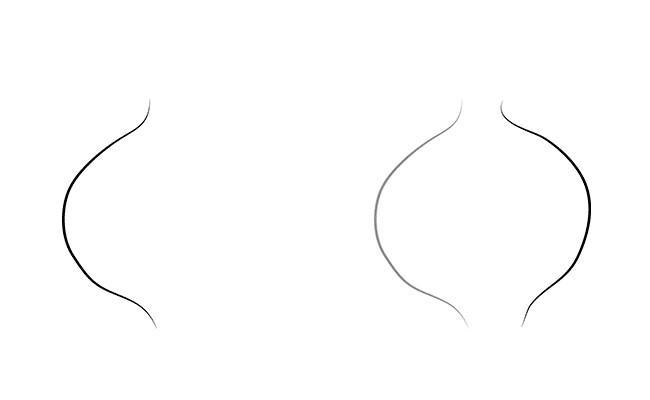
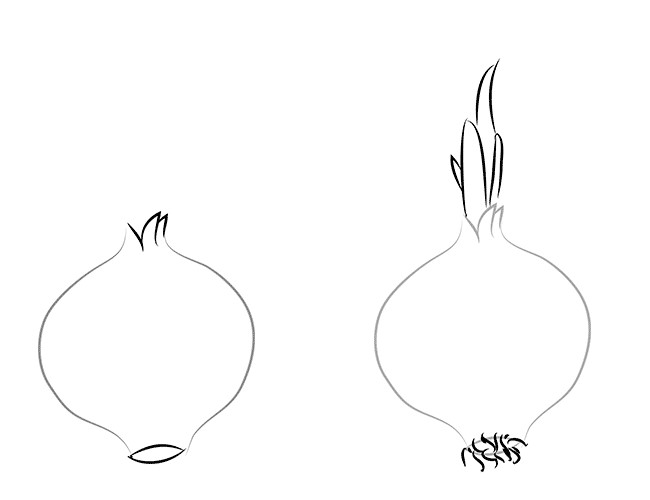

- Finish drawing the right side of the bulb. The outlines should be approximately similar.
- Draw an oval at the bottom, connect the right and left parts of the onion. Draw zigzag lines at the top, forming the upper edge of the husk.
- In the lower part, on the previously drawn oval, depict curved short roots. In the upper part, using the uneven edge of the husk as a base, add a bunch of greenery.
- Oblong figures with slightly pointed ends can be of different sizes and lengths.
- On the surface of the peel, show the guide lines that form the texture of the vegetable. Add a shadow by painting the side areas of the bulb. At the same time, hatch individual cells of the peel.
- Draw the area of partial shadow that extends over the lower and upper parts of the bulb, and also slightly encroaches on the middle of the vegetable.
You can also add some elements colored with a gel pen. The contours of the product, as well as small details, can be duplicated with a black pencil or a felt-tip pen with a thin lead.
On the table
You can also draw a simple onion without greenery.
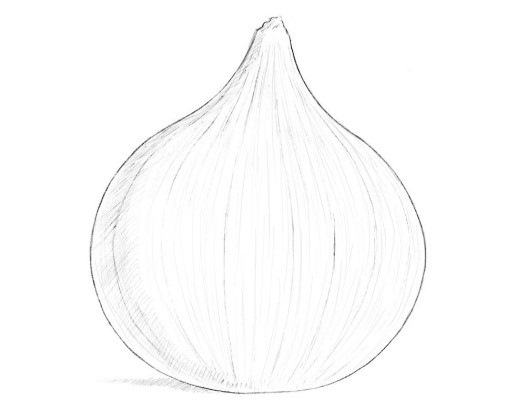
This option is suitable for use in various still lifes and other paintings.
Step by step process of execution
Algorithm for performing work:
- Using a thin pencil lead, draw a large circle on a clean sheet of paper. The lines should be light, as adjustments will be required as you continue to work.
- Draw 2 lines upwards, starting after the side bends. The lines should smoothly converge at the top, forming the head of the bow.
- Use an eraser to remove all unnecessary elements of the drawing. Use a sharp pencil with a hard lead to duplicate the outline of the drawn figures to create the base of the onion.
- Draw the texture of the onion peel. Draw the entire area of the onion with curved vertical lines. The lines should not be the same. Be sure to use lines of different lengths, form small notches.
- Create a more voluminous drawing. Add light shadows, highlighting the area with hatching. Also add a light shadow under the side and bottom area of the bulb.
- Finally, you can add a flat, long table surface and add the characteristic wood texture.



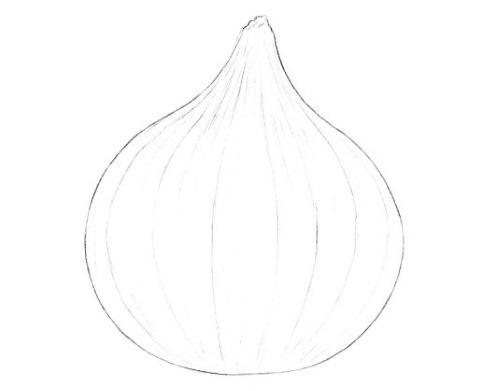
The image can be left as is. You can also use colored pencils and paints to make the drawing more realistic.
How to color the image correctly:
- Orange or beige is used as a base. You can also paint the bow purple.
- Fill the entire area of the drawing with the main shade.
- Use a bright orange shade to draw the center of the bulb to indicate the location of the highlights and the lightest point.
- Using a brown pencil or paint, add shadows to the side areas of the bulb and fill in the top.
- Use a black or grey shade to draw a shadow under the bulb.
- You can also add subtle highlights in white on the glossy peel, depending on the placement of the light in the painting.
The resulting drawing must be carefully dried in a horizontal position.
Coloring pages for copying
Children can also be offered coloring pages and images to copy:
- For younger children, it is recommended to offer large pictures with large elements in order to introduce them to new elements. Cartoon-style coloring is also suitable so that learning takes place in a game format;
- when the first stage of acquaintance is passed, you can begin to get acquainted with the natural "habitat" of the plant. For this, it is better to use coloring pages with beds, vegetable gardens or home pots. At the same time, you should not overload the child and use images with an abundance of elements. 2-3 bulbs and the space around them are enough;
- then you can introduce various pictures. They will help not only in the development of fine motor skills and imagination of the child, but also allow you to learn vegetables. In the process of coloring, you can ask the child questions that allow you to learn or test knowledge of fruits and vegetables;
- Coloring with vegetable halves also looks relevant. It will allow the child to study the internal structure of the product, as well as train the imagination. At the same time, you should not limit yourself to only the classic onion, but also talk about different varieties of vegetables.

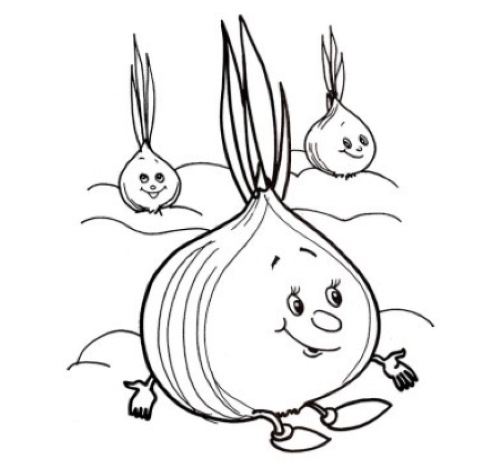

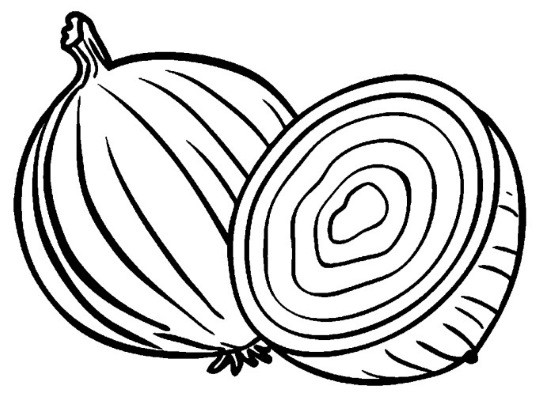
Coloring pages have many purposes. If the child is still learning, or the picture has several purposes, it is recommended to make 2-3 copies of the picture. You can also practice ingenuity and accuracy by copying the image onto an album sheet.
To perform the procedure, you need to provide the child with good light and comfortable devices. It is also necessary to recommend that children independently correct the resulting image at their own discretion.
Onion is one of the most ancient plants, which was known as early as 3000 BC. The product was widely used in many areas of human activity, from cooking to magic. Its distinctive property - tearfulness, is explained by the content of a substance called lachrymator.
Its release into the air irritates the mucous membrane of the eye, which leads to lacrimation. You can introduce children to vegetables (including onions) using drawings and various coloring pages, as well as watching cartoons (Cipollino, Luntik (Onion Day)).
Video about drawing
Onion drawing for kids:
